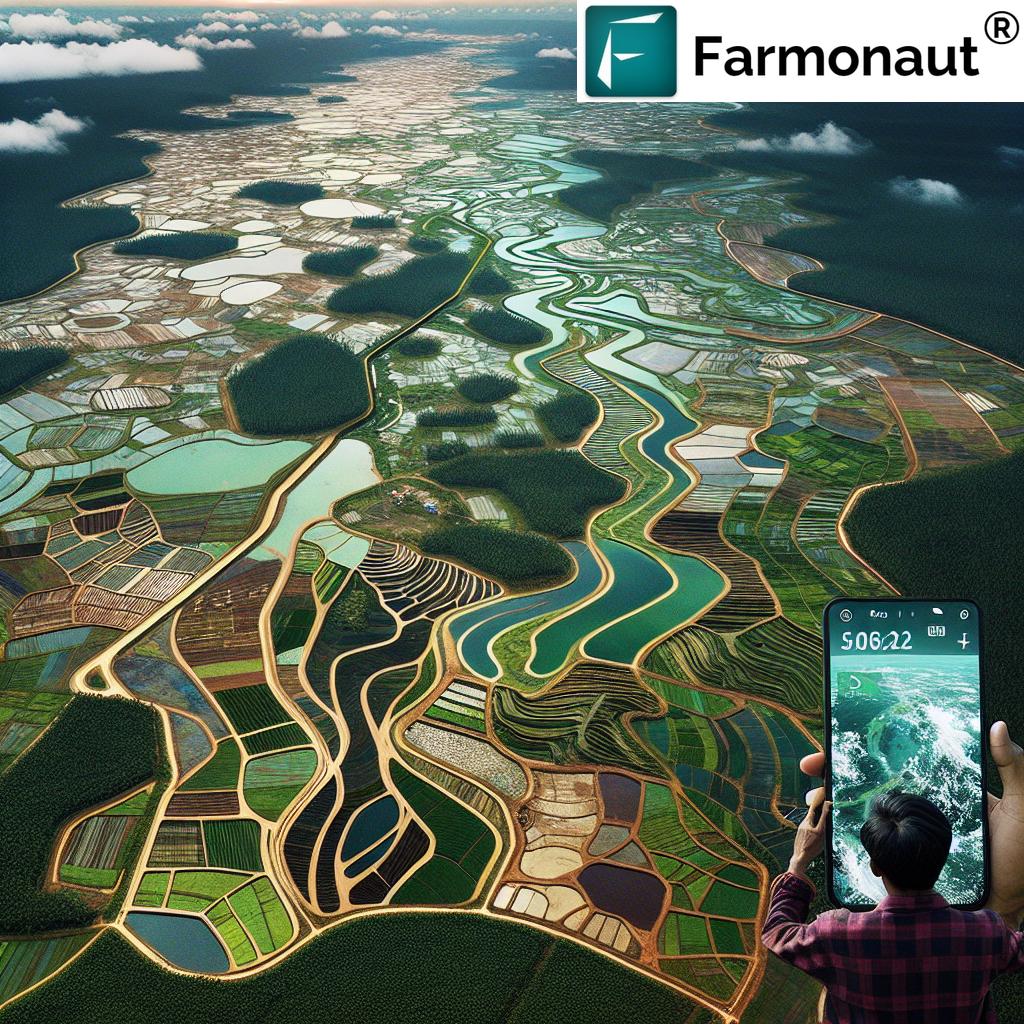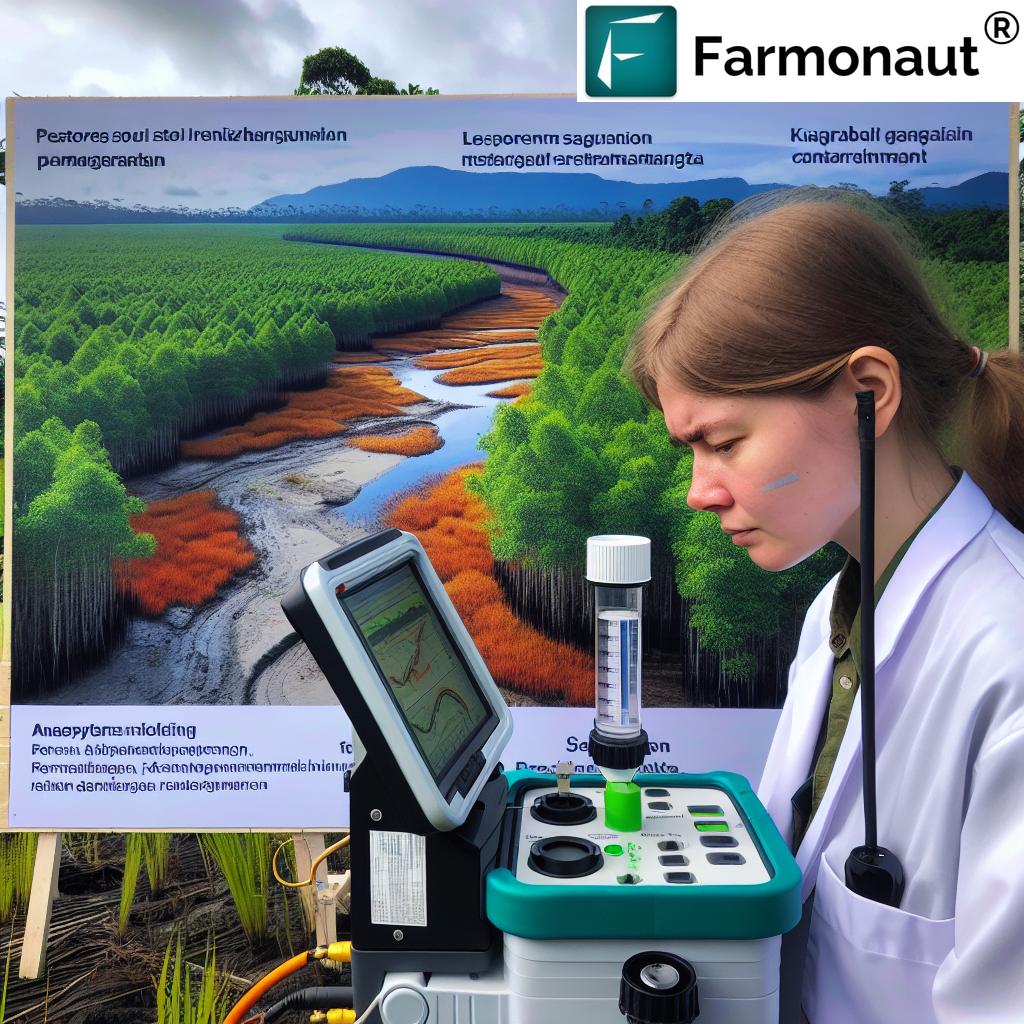Farmonaut’s Guide: Sustainable Peatland Management in Indonesia for Climate Change Mitigation and Agricultural Innovation

“Indonesia aims to reduce emissions by 29% by 2030 through improved peatland management strategies.”
Welcome to Farmonaut’s comprehensive guide on sustainable peatland management in Indonesia. As experts in agricultural technology and remote sensing, we’re excited to explore the innovative approaches being implemented to conserve peat ecosystems and revolutionize agricultural practices in this critical region. Join us as we delve into the challenges, solutions, and future prospects of peatland management in Indonesia, with a focus on climate change mitigation and agricultural innovation.
The Importance of Peatlands in Indonesia
Indonesia’s peatlands are a vital component of the global ecosystem, covering approximately 24 million hectares across the archipelago. These unique landscapes play a crucial role in:
- Carbon storage
- Hydrological regulation
- Biodiversity support
- Economic activities
However, unsustainable management practices, particularly excessive drainage, have led to significant challenges, including:
- Land subsidence
- Increased greenhouse gas (GHG) emissions
- Destructive fires
- Economic losses
To address these issues and promote sustainable peatland management, the Indonesian government has implemented various initiatives and strategies.
Government Initiatives for Sustainable Peatland Management
The Indonesian government has recognized the urgent need for improved peatland management to reduce GHG emissions and mitigate climate change impacts. Some key initiatives include:
- Enhanced Nationally Determined Contribution (ENDC): Indonesia has pledged to reduce GHG emissions by 29% by 2030.
- Peatland and Mangrove Restoration Agency: Established to oversee restoration efforts and implement sustainable management practices.
- Deforestation prevention: Measures to curb illegal logging and land conversion in peatland areas.
- Fire prevention and management: Improved strategies to prevent and control peatland fires.
These efforts demonstrate Indonesia’s commitment to sustainable peatland management and its role in global climate change mitigation.
The Peat-IMPACTS Project: A Collaborative Approach
One of the most promising initiatives in sustainable peatland management is the Peat-IMPACTS project. This collaborative effort involves:
- The Agriculture Ministry
- The International Center for Research in Agroforestry (ICRAF)
- The National Research and Innovation Agency (BRIN)
The project, initiated in 2020, focuses on two key regions:
- South Sumatra
- West Kalimantan
The main objectives of Peat-IMPACTS include:
- Enhancing peat landscape management
- Boosting farmer capacity through specialized training
- Implementing sustainable agricultural practices
- Empowering local communities and stakeholders
By expanding these successful practices throughout Indonesia, the project aims to yield significant benefits both nationally and globally.
Innovative Approaches to Peatland Agriculture
Sustainable peatland management requires innovative agricultural practices that balance productivity with ecosystem conservation. Some key approaches include:
- Agroforestry: Integrating trees and crops to improve soil health and biodiversity
- Paludiculture: Cultivating wetland-adapted crops to maintain high water tables
- Precision agriculture: Using technology to optimize resource use and minimize environmental impact
At Farmonaut, we’re proud to contribute to sustainable peatland agriculture through our advanced satellite-based farm management solutions. Our platform offers:
- Real-time crop health monitoring
- AI-based advisory systems
- Resource management tools
Try Farmonaut’s web app to experience how technology can revolutionize peatland agriculture.
Remote Sensing and GIS in Peatland Management
Remote sensing and Geographic Information Systems (GIS) play a crucial role in sustainable peatland management. These technologies offer:
- Accurate mapping of peatland extent and depth
- Monitoring of land use changes and deforestation
- Early detection of hotspots and potential fire risks
- Assessment of hydrological conditions
Farmonaut’s satellite-based solutions leverage these technologies to provide valuable insights for peatland management. Our platform enables:
- Vegetation health monitoring through NDVI analysis
- Soil moisture assessment
- Crop yield estimation
Explore our API and API Developer Docs to integrate these powerful tools into your peatland management strategies.
Peatland Restoration Techniques
Restoring degraded peatlands is essential for maintaining hydrological balance and reducing GHG emissions. Key restoration techniques include:
- Rewetting: Blocking drainage canals to raise water tables
- Revegetation: Planting native species to restore peat-forming vegetation
- Fire prevention: Implementing measures to reduce fire risk in restored areas
- Community involvement: Engaging local communities in restoration efforts
These techniques aim to restore the natural functions of peatlands while supporting sustainable livelihoods for local communities.
“Indonesia’s peatlands store an estimated 57 gigatons of carbon, equivalent to 5-6 years of global fossil fuel emissions.”
Challenges in Peatland Management
Despite progress in sustainable peatland management, several challenges remain:
- Balancing economic development with conservation
- Addressing land tenure issues and conflicts
- Improving law enforcement to prevent illegal activities
- Enhancing coordination between different government agencies and stakeholders
- Securing long-term funding for restoration and management efforts
Overcoming these challenges requires a multi-faceted approach and collaboration between various sectors.
The Role of Technology in Peatland Management
Innovative technologies are playing an increasingly important role in sustainable peatland management. At Farmonaut, we’re at the forefront of this technological revolution, offering solutions that support:
- Precision agriculture in peatland areas
- Monitoring of peatland health and restoration progress
- Data-driven decision-making for policymakers and land managers
Download our mobile apps to experience these innovative solutions:
Sustainable Peatland Management Strategies in Indonesia
| Management Strategy | Implementation Region | Key Benefits | Challenges |
|---|---|---|---|
| Peat-IMPACTS project | South Sumatra, West Kalimantan | Enhanced peat landscape management, improved farmer capacity | Scaling up to other regions, ensuring long-term sustainability |
| Agroforestry techniques | Various peatland areas across Indonesia | Improved soil health, increased biodiversity, sustainable income for farmers | Changing traditional farming practices, market access for new products |
| Remote sensing applications | Nationwide | Accurate mapping, early fire detection, monitoring of land use changes | Technical expertise required, data interpretation challenges |
| Peatland restoration | Degraded peatlands across Indonesia | Reduced GHG emissions, improved hydrological function, fire prevention | High costs, technical complexities, community engagement |
The Global Significance of Indonesia’s Peatland Management
Indonesia’s efforts in sustainable peatland management have far-reaching implications beyond its borders. By effectively managing its peatlands, Indonesia contributes to:
- Global climate change mitigation
- Biodiversity conservation
- Sustainable development models for other tropical peatland countries
The success of Indonesia’s peatland management strategies could serve as a blueprint for other nations facing similar challenges.
Future Prospects and Opportunities
As Indonesia continues to refine its peatland management strategies, several opportunities emerge:
- Development of innovative peatland-friendly crops and products
- Expansion of carbon credit markets for peatland conservation
- Increased international collaboration and knowledge sharing
- Integration of advanced technologies for monitoring and management
These opportunities present exciting possibilities for sustainable development and environmental conservation in Indonesia’s peatland regions.
Farmonaut’s Contribution to Sustainable Peatland Management
At Farmonaut, we’re committed to supporting sustainable peatland management through our innovative agricultural technology solutions. Our platform offers:
- Satellite-based crop health monitoring for peatland agriculture
- AI-driven advisory systems tailored for peatland conditions
- Resource management tools to optimize water and nutrient use in peatlands
- Carbon footprint tracking to support emissions reduction efforts
By leveraging these technologies, farmers, policymakers, and researchers can make data-driven decisions to promote sustainable peatland management practices.
Experience Farmonaut’s innovative solutions:
Conclusion
Sustainable peatland management in Indonesia is crucial for mitigating climate change, preserving biodiversity, and supporting local livelihoods. Through collaborative efforts, innovative technologies, and comprehensive strategies, Indonesia is making significant strides in balancing conservation with economic development in its peatland regions.
As we continue to face global environmental challenges, the lessons learned from Indonesia’s peatland management initiatives will be invaluable. By embracing sustainable practices and leveraging cutting-edge technologies like those offered by Farmonaut, we can work towards a future where peatlands are preserved, emissions are reduced, and agriculture thrives in harmony with nature.
FAQs
- What are peatlands, and why are they important?
Peatlands are wetland ecosystems characterized by the accumulation of partially decayed plant material. They are crucial for carbon storage, water regulation, and biodiversity support. - How does peatland drainage contribute to climate change?
Drainage exposes peat to oxygen, leading to rapid decomposition and the release of stored carbon as CO2, contributing to greenhouse gas emissions. - What is paludiculture, and how does it benefit peatland management?
Paludiculture is the practice of cultivating wetland-adapted crops on wet or rewetted peatlands. It helps maintain high water tables, reducing emissions and supporting sustainable agriculture. - How can remote sensing technology assist in peatland management?
Remote sensing enables accurate mapping of peatland extent, monitoring of land use changes, early fire detection, and assessment of vegetation health, supporting informed decision-making. - What role do local communities play in sustainable peatland management?
Local communities are essential for successful peatland management. Their involvement ensures the implementation of sustainable practices, provides valuable traditional knowledge, and supports long-term conservation efforts.

Farmonaut Subscriptions







